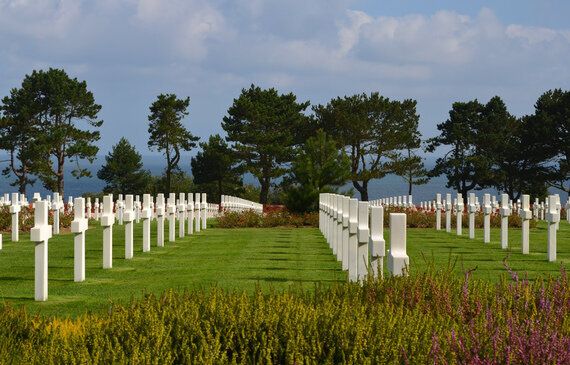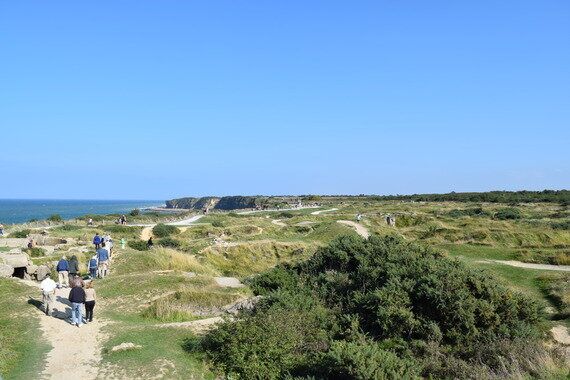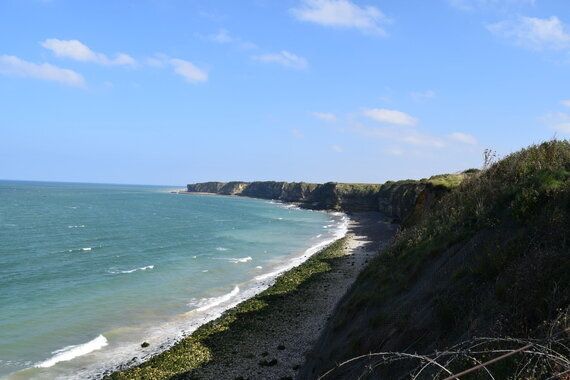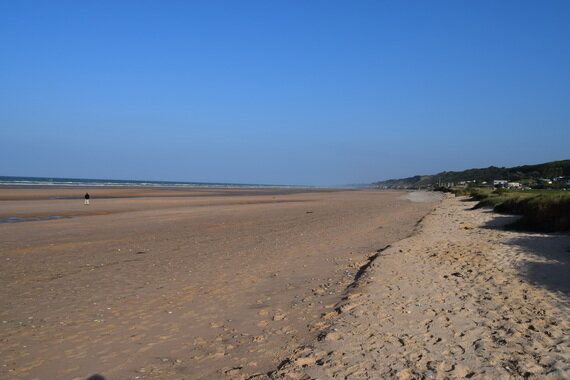Continuing my trip to the D-Day beaches, I moved from the D-Day sites and museums in the British and Canadian sector into the American sector.
First up was an early morning visit to the Longues-sur-Mer gun battery. The battery is one of the most remarkably preserved sections of the Atlantic Wall, the extensive series of fortifications along France's coast that were created by Hitler to protect against seaborne invasion from England. Today, the 4 casemates house the original guns that fired on both Omaha and Gold Beach on D-Day until the battery was taken out by artillery fire from the Allied naval bombardment.

© Brittany Ferries, Samantha Wills
Over 9,000 of the young American soldiers who died during D-Day and the Battle of Normandy are buried in the American Cemetery that overlooks Omaha Beach today. It is a horrifying figure that is difficult to comprehend but here those statistics have names and, importantly, something that the world can remember each and every one of them by.
Family members are buried side by side including father and son Ollie Reed and Ollie Reed Jnr who were both killed in July 1944 - the father in Normandy and the son in Italy. I try to avoid crying in public but my resolve nearly broke when I was told of how Mildred Reed received the telegrams of her husband's and her son's deaths within 45 minutes of each other. Theirs is a heart-breaking human story of a family torn apart by the war with not just one but two generations lost.
All of the men buried here died in the 100 days of the Battle of Normandy and many more were returned to their families in America. The scale is staggering but the cemetery is a peaceful spot despite the number of visitors. Everyone is here to pay respects.

© Brittany Ferries, Tony Butcher
Not far down the coast is the spectacular setting of Pointe du Hoc where a group of American Rangers scaled the 100ft cliff to take out the guns that were expected to fire on Omaha Beach. Discovering that the guns had been removed, the Rangers forced the surrender of the remaining German troops but had to hold off several German counterattacks in order to keep the high ground for two days until they were relieved. Of over 200 Rangers who scaled the cliffs, only 90 survived.

© Brittany Ferries, Samantha Wills
Today, the site is looked after by the American Battle Monuments Commission (ABMC) like the American Cemetery. It has recently opened its visitors centre in time for the 70th anniversary and I would urge you to spend some time here learning about the mission and watching the short film before you go outside. Kids will be fascinated by the wild landscape that has been left much as it was at the end of the war, still cratered by the Allied bombing campaign, but the rugged terrain means you should keep them to the paths - and have an eye on them at all times!

© Brittany Ferries, Samantha Wills
If I'd had more time, I'd have like to have headed west to Utah Beach and the Carentan area where paratroopers were engaged in fierce fighting trying to free the land between the Omaha and Utah beaches, but I hope that I can go back soon.
Although all the beaches are important to understand the scale of what happened here, it is at Omaha Beach that you truly begin to understand the sheer enormity of the invasion. I have not visited every cove of Normandy's coastline but I think Omaha must be one of the region's most stunning beaches. It is sad that man has left his mark so that such a beautiful place where the freedom, power and beauty of nature are so inspiring should forever have its reputation as the site of one of the greatest horrors in our history. At least 2,000 American soldiers died here on the first day, some historians suggest the number could be more like 3,000.
It is impossible not to begin visualising in your mind's eye, the terrors that happened here and by this time I had stopped trying to push those thoughts away. The beautiful, flat expanses of sand whose freedom attracts joggers, kitesurfers and many more adventure seekers today meant that, in 1944, there was nowhere to hide from enemy fire and hundreds of soldiers were cut down before they could reach anywhere close to the shelter of the cliffs.

© Brittany Ferries, Samantha Wills
Standing on the beach, taking the above photograph, it occurred to me that a soldier, perhaps a boy of only 17, could have drawn his last breath where my feet now stood. Morbid, I know, but it's a humbling and disquieting thought. A very different scene would have greeted me through the lens compared to this serene, picturesque view. I have seen the film Saving Private Ryan; I have seen the television series Band of Brothers; I have seen countless black and white photographs and some incredible film reels, but none of them have managed to capture my imagination as it was caught whilst standing quietly on that lonely beach with my camera.
Without being there, where these incredible, terrifying moments in history actually happened, you cannot truly appreciate the audacity, ingenuity and courage of these men to undertake such a remarkable mission as Operation Overlord. I know that I did not.
Stand on the beaches, visit the cemeteries, look out to sea from the bunkers and gun batteries - and you will see a world so different from our own but one that is also very familiar. It is a world of human stories, of brave and courageous men who deserve to be remembered for what they faced and what they achieved. You will always remember them. After a visit to Normandy, they will always walk with you.
For more information about the D-Day sites, visit www.normandy-tourism.org and www.calvados-tourisme.co.uk.